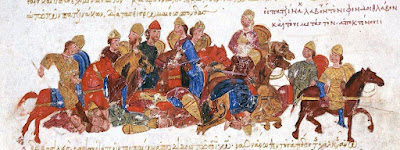Battle of Levounion, Aprill 29, 1091
The Battle of Levounion was the first Byzantine victory of the Komnenian revival. On April 29, 1091, a force of Pechenegs invading the empire's territories was crushed by the combined forces of the Byzantine Empire under Alexios I Comnenus and his Cuman allies.
Background
After the defeat of the Byzantine army by the Seljuk Turks in the battle of Manzikert, Duke Michael VII refused to honor the agreement signed by Romanos IV. In response the Turks began to move into Anatolia in 1073, meeting no resistance. Alexios Comnenus, a successful young general, ascended the throne on Easter Day, 1081. According to Norwich, his recovery to the throne was of great importance, as "...for the first time in about half a century the empire was in able hands". Alexios was determined to change the fortunes of the empire at any cost. In 1090 or 1091, Emir Tsaka of Smyrna allied with the Pechenegs in order to completely destroy the Byzantine Empire.
Invasion of the Pechenegs
In the spring of 1087 the Pechenegs invaded the territories of the empire from the northwestern Black Sea region with an army of about 80,000 men. Taking advantage of Byzantium's political anomaly at the time, the Pecheneg horde headed for the Byzantine capital, Constantinople, plundering the northern Balkans on its way. The raid posed a serious threat to the empire, as due to civil strife the Byzantine army did not have enough troops to repel the invaders. Alexios I, in his attempt to regain numerical superiority, turned to another nomadic tribe, the Cumans, with whom he allied against the Pechenegs.
The battle
Lured by the Byzantines' offer of gold in return for their help against the Pechenegs, the Cumans rushed to join Alexius and his army. In the late spring of 1091, Cuman forces crossed into Byzantine territory, and the army as a whole prepared to advance against the Pechenegs. On Monday, April 28, 1091, Alexios and his allies approached the Pecheneg camp in Levunia near the Ebro River.
The Pechenegs seem to have been taken by surprise, and the battle that took place the next morning at Levunion was practically a massacre. The Pechenegs had brought their women and children with them, and were unprepared for the attack that was launched against them. The Cumans and Byzantines attacked with ferocity and slaughtered everyone in their path. The Pechenegs quickly collapsed, and were almost exterminated. Then the remaining survivors were released.
 |
| The Byzantine emperor Alexios I Komnenos |
Importance
The battle of Levouni was the most decisive victory of the Byzantine army for a period of half a century and marks a turning point in Byzantine history. The empire had been at its nadir for the past twenty years, and Levunion showed that it was on the road to recovery. The Pechenegs were completely destroyed and the European possessions of the empire were secure. Alexios showed himself to be the savior of Byzantium in its time of need and gave a new spirit of rebirth to the weak Byzantines due to frequent wars.
 |
| The Byzantine emperor Alexios I Komnenos |
In the years following the battle, the empire experienced a veritable renaissance under Alexius and his descendants, the so-called Komnenian dynasty. The Byzantine army returned to Asia Minor, recovering the lost territories, among them the fertile coasts and many important cities. With the restoration of stability in the central government the autocracy once again became wealthy for another century, while Constantinople once again became the metropolis of Christendom.
Referrals
John W. Birkenmeier. The Development of the Komnenian Army: 1081-1180 , σ. 76, Brill Academic Publishers, 2002, ISBN 90-04-11710-5.
W. Treadgold. A History of the Byzantine State and Society, σ. 617.
Sources
John Julius Norwich (1997), A Short History of Byzantium, Viking, ISBN 0-679-77269-3
Haldon, John (2001), The Byzantine Wars, Tempus, ISBN 0-7524-1777-0
Angold, Michael (1997), The Byzantine Empire, 1025–1204, A Political History, Longman, ISBN 0-582-29468-1
This article incorporates text from the Wikipedia entry, which is distributed under the GNU FDL and CC-BY-SA 3.0.




Σχόλια